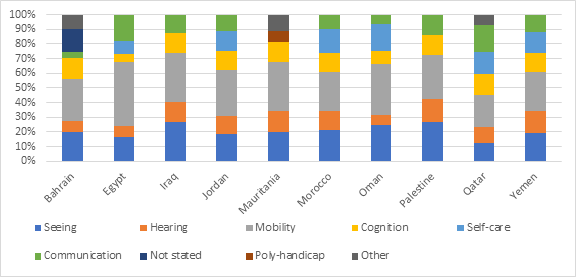Table of contents:
Types of Disability
As shown by figure 6, the data indicate that there are large divergences between countries in terms of which types of disabilities are most common. However, differences in how the data have been collected and classified may have influenced the result and affect the comparability. Ten of the 11 countries for which data on disability type are available have for the most part used the disability types recommended by the WGSS – seeing, hearing, mobility, cognition, self-care and communication – although Bahrain, Iraq, Mauritania and Palestine have not included self-care.[1] Mauritania has also excluded communication. Seven countries – Iraq, Jordan, Morocco, Palestine, Qatar, Sudan and Yemen – have allowed for multiple disability types per person, meaning that the total number of disability instances in these countries is higher than the total number of persons with disabilities. It is not clear how, if at all, this might have affected the relative prevalence of specific disability types.
Figure 6: Types of disabilities as percentage of total

Source: Calculated from Arab Disability Statistics in Numbers 2017, based on data compiled and verified from National Statistics Offices (NSOs) from the following censuses and surveys: Bahrain Census 2010, Egypt Labor Force Survey (LFS) 2016, Iraq Poverty and Maternal Mortality Survey (I-PMM) 2013, Jordan Census 2015, Mauritania Census 2013, Morocco Census 2014, Oman Census 2010, Palestine Census 2007, Qatar Census 2010, Yemen Household Budget Survey (HBS) 2014.
Note: Data for Sudan have not been included in the chart since Sudan uses a completely different typology.
Disabilities related to mobility are the most common type in all countries. In Egypt, they account for as much as 43.3 per cent of all disabilities, whereas Qatar has the lowest proportion at 21.6 per cent. Qatar also has the lowest share of disabilities related to seeing, at 12.6 per cent, in contrast to Palestine and Iraq where this disability type represents 26.5 per cent. Disabilities pertaining to hearing make up between 10.8 and 15.9 per cent of the total in all countries apart from Bahrain and Egypt, where the respective shares are 7.1 and 7.7 per cent. Cognitive disabilities amount to 5.7 per cent of disabilities in Egypt, 9.4 per cent in Oman and between 13.1 and 14.5 per cent in all other countries.
The spread is even more considerable for communication difficulties. In Bahrain, this form of disability represents a mere 4.3 per cent of total disabilities – less than one fourth of the proportion in Qatar, at 18.8 per cent. The proportions relating to self-care are similarly divergent, spanning between 8.7 per cent in Egypt and 18.3 per cent in Oman. For Qatar, Bahrain and Mauritania, there is a residual category for “other” disabilities, which in the three countries account for 6.9, 9.5 and 11.3 per cent respectively. Bahrain has a category called “not stated” which makes up 15.7 per cent of all disabilities, whereas Mauritania has one for “poly-handicap” at 7.5 per cent.
There are some clear differences in the distribution of disability types among women and men. The biggest divergence in proportional terms is found in Bahrain, where the share of communication difficulties as a percentage of all disabilities among women is 2.5 per cent, while the rate is more than twice as high among men at 5.4 per cent. In Yemen, cognition, self-care and communication make up a considerably higher share of total disabilities among men than among women, whereas the female proportion of disabilities related to seeing is higher than the male one.
As noted above, methodological differences between countries have in all likelihood impacted the picture. For instance, the fact that one quarter of disabilities in Bahrain have been reported as “other” or ”not stated” has presumably lowered the rates of other disability types. Additional factors behind the differing outcomes may include variations in terms of the average age of persons with disabilities, the inclusion by some countries of non-nationals and, as will be shown below, that certain causes of disability are more common in some countries.
[1] Sudan has used a typology which differs completely from the one recommended by the Washington Group and is therefore not included in this discussion. Its data are based on 11 disability types: limited use of legs, loss of legs, limited use of arms, loss of arms, difficulty in hearing, deafness, difficulty in seeing, blindness, difficulty in speaking, muteness, mental disability. See country profile.